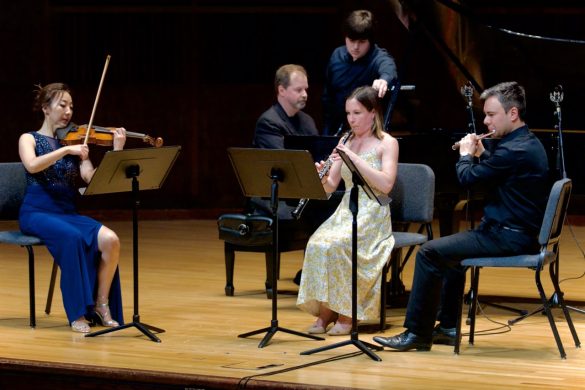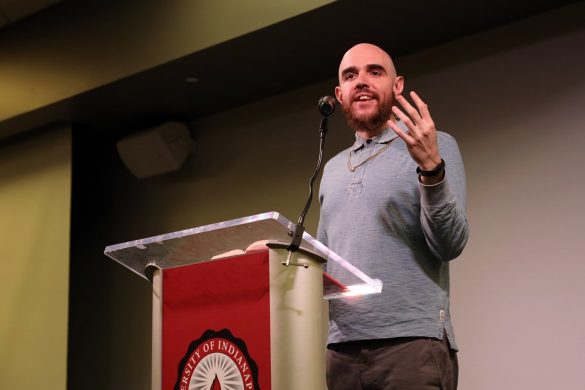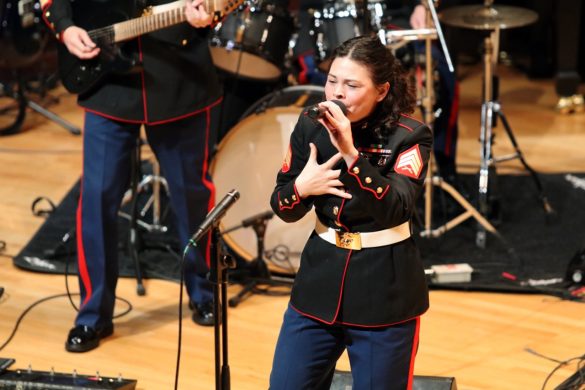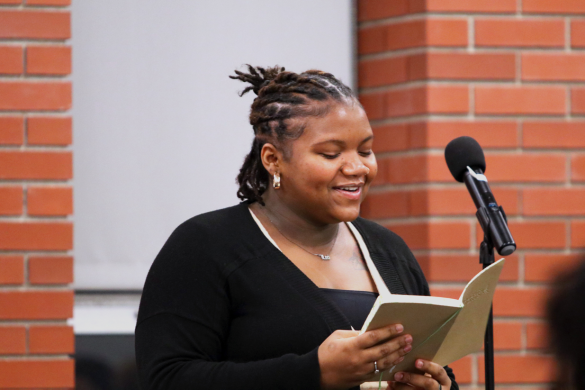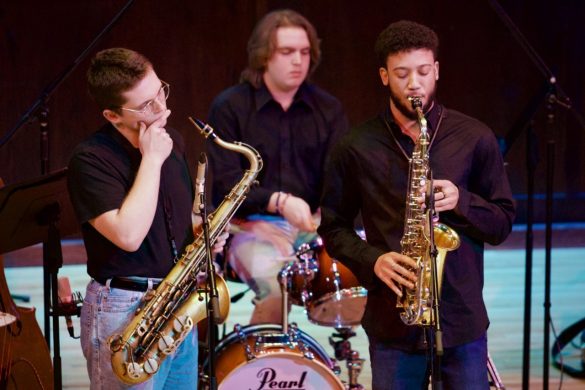
The University of Indianapolis Chamber Winds and Percussion perform “Overture to Candide” by Leonard Bernstein. Photo by Angelica Mercado
A variety of music styles were performed by the University of Indianapolis Chamber Orchestra and Symphonic Wind Ensemble on Nov. 10 at 7:30 p.m. in the Ruth Lilly Performance Hall. The performers were directed by Assistant Professor of Music and violinist Austin Hartman and Assistant Professor of Music and Director of Bands Vu Nguyen.
The orchestra hosted musical guests such as Adriana Contino, a visiting professor from Anderson University and cellist, and associate adjunct professor of music and cellist Dennis McCafferty for the “Concerto of Two Cellos in G Minor, RV 531,” composed by Antonio Vivaldi. The two cellos were the centerpiece for the three-part concerto: allegro moderato, largo and allegro.
Contino and McCafferty began the medley and then were joined by UIndy’s orchestra.
“I like the mix, and I like that about professor Hartman. He’s mixing faculty and professional musicians with students. It’s great. It’s a little bit of a challenge because the students think of themselves often as followers and students,” Contino said, “but we are motivating them to take responsibility and to lead. I think that’s happening more and more.”

Adriana Contino, Dennis McCafferty and the University of Indianapolis Chamber Orchestra perform “Concerto for Two Cellos in G Minor” by Antonio Vivaldi. Photo by Angelica Mercado
The chamber orchestra and Contino performed, “Pièces en Concerto for Cello and Strings,” by François Couperin. In this piece, the cello and student string players were showcased through a series of pieces that emphasized dynamics and tempo changes.
“I really feel that this generation is afraid of coming forward with their energy, and my [really] heartfelt tip is that people need to express themselves more and lead more. In other words, to say it bluntly, there’s a passivity, and I don’t like to see that,” Contino said. “I always try to awaken people to be who they are and really come forward. I think that there are some reasons for that, because in education you often [get sort of] penalized for being yourself and maybe you stop coming forward because it’s not having the effect you want. In music, that means really making a statement, taking a chance and being willing to make a mistake. When you perform, you really have to give it to the audience, and there’s no holding back.”
The orchestra concluded its portion of the night with “Suite for Strings,” a series of folksongs by John Rutter.
“Instrumental music doesn’t have words, but it should have the effect of words. It’s just that the person listening can make up whatever it is in their own minds and their hearts. That’s the goal because, I think, everything is sort of a language. Music is a language,” Contino said.
The Percussion Ensemble, directed by Paul Berns, began its portion of the night with “October Mountain,” by Alan Hovhaness, a sextet that explores the color and dynamic ranges of the various percussion instruments, according to Nguyen. Nguyen directed “Petite Symphonie,” IV Finale, by Charles Gounod, was performed by the Symphonic Wind Ensemble.
“We have a good amount of freshmen in the group, and some of them have been going through a lot of changes as far as how they play their instruments, or playing roles that they have never been in before, like a lead role,” said sophomore music education major and trumpet player Breann Royer. “So [we try] reassuring their worries and just encouraging them when [we] hear them doing something or struggling with something such as a rhythm that they haven’t gotten.”

Dr. Vu Nguyen acknowledges veterans in the band and audience, thanking them for their service. Photo by Angelica Mercado
The Wind Ensemble continued with “Overture to ‘Candide,’” by Leonard Bernstein, based on Voltaire’s operetta of the same name, and “O Magnum Mysterium,” by Morten Lauridsen, referring back to the birth of Jesus Christ, according to Nguyen.
The Symphonic Wind Ensemble concluded the performance with the familiar “Symphony No. 9” (From the New World), by Antonin Dvořák.
“For me, when I am playing music, the whole goal is to sing through the instrument and to portray an image, so that kind of starts with you having an image of what the music means to you or what it makes you think of, [meaning] creating that story for yourself and then translating that through your instruments to your audience,” Royer said. “[That way] you’re just playing with emotion. There’s a big difference from just playing notes and rhythms. We can all play notes and rhythms. So playing with emotion and portraying that makes a big difference.”
The Faculty Artist Concert Series will present its event “Trumpetworks!,” featuring music from the Baroque period to Billy Joel, on Nov. 28 at 7:30 p.m. in the Ruth Lilly Performance Hall.


